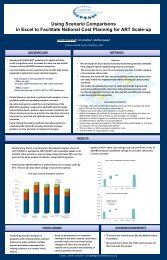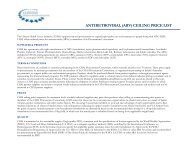HIV/AIDS in Ethiopia: - Clinton Health Access Initiatives
HIV/AIDS in Ethiopia: - Clinton Health Access Initiatives
HIV/AIDS in Ethiopia: - Clinton Health Access Initiatives
Create successful ePaper yourself
Turn your PDF publications into a flip-book with our unique Google optimized e-Paper software.
Initiative 2- adult 2 nd l<strong>in</strong>e antiretroviral scale upBACKGROUNDAntiretroviral treatment, once <strong>in</strong>itiated, is a life-long commitment for people liv<strong>in</strong>g with <strong>HIV</strong>.Over time, the virus <strong>in</strong>evitably becomes resistant to the 1st l<strong>in</strong>e of prescribed treatment andpatients must move to a newer, more potent class of 2nd l<strong>in</strong>e ARV drugs. Unfortunately, at atime when more and more <strong>HIV</strong> positive patients are requir<strong>in</strong>g 2nd l<strong>in</strong>e treatment, the new-tomarketclass of 2nd l<strong>in</strong>e drugs rema<strong>in</strong>s significantly more expensive than established generic1st l<strong>in</strong>e treatments. In early 2007, at the start of the UNITAID/CHAI 2nd l<strong>in</strong>e ART scale up, theprice of a 2nd l<strong>in</strong>e antiretroviral treatment regimen was roughly 10 times higher than a suitable1st l<strong>in</strong>e therapy. Under this type of pric<strong>in</strong>g structure, the ARV treatment cost of a populationdoubles when only 10 percent of patients come to require 2nd l<strong>in</strong>e therapy. Recogniz<strong>in</strong>g thesituation as untenable, UNITAID and CHAI moved forward with the m<strong>in</strong>dset of alter<strong>in</strong>g theexist<strong>in</strong>g pharmaceutical landscape for 2nd l<strong>in</strong>e <strong>HIV</strong>. Putt<strong>in</strong>g forward a plan to <strong>in</strong>crease access totreatment <strong>in</strong> 25 countries, the <strong>in</strong>itiative concentrated on two primary objectives—reduc<strong>in</strong>g theprice of 2nd l<strong>in</strong>e therapy and <strong>in</strong>creas<strong>in</strong>g the number of suppliers.>50PERCENT DECREASE IN THECOST OF 2ND LINE ARV 13,958ETHIOPIAN ADULTS ON 2NDLINE THERAPY (2007-2010)PROGRAM ACCOMPLISHMENTSREDUCING THE COST OF TREATMENTUnlike the pediatric ARV program, the objectiveof the UNITAID funded and CHAI-<strong>Ethiopia</strong>implemented adult 2nd l<strong>in</strong>e ARV <strong>in</strong>itiative was notfocused on plac<strong>in</strong>g more patients on treatment.Indeed, the goal of <strong>Ethiopia</strong>’s nationwide <strong>HIV</strong>treatment program is to m<strong>in</strong>imize the numberof patients requir<strong>in</strong>g a switch from 1st to 2ndl<strong>in</strong>e ARVs. Notwithstand<strong>in</strong>g, after synthesiz<strong>in</strong>gepidemiological data and national protocolsfor ARV treatment, CHAI’s forecast<strong>in</strong>g model<strong>in</strong>dicated an impend<strong>in</strong>g change <strong>in</strong> the demandfor key 2nd l<strong>in</strong>e products as patients migrated<strong>in</strong> <strong>in</strong>creas<strong>in</strong>g numbers from 1st l<strong>in</strong>e to 2nd l<strong>in</strong>eregimens.The need for <strong>in</strong>creased access to 2nd l<strong>in</strong>etreatment was clear; the barrier was price.To overcome this hurdle, the adult 2nd l<strong>in</strong>eARV <strong>in</strong>itiative addressed exist<strong>in</strong>g market<strong>in</strong>efficiencies, with the <strong>in</strong>tention of m<strong>in</strong>imiz<strong>in</strong>gthe cost of treat<strong>in</strong>g these patients and enabl<strong>in</strong>gsystem-wide sav<strong>in</strong>gs over time by broker<strong>in</strong>gsignificant reductions <strong>in</strong> price. By tapp<strong>in</strong>g<strong>in</strong>to CHAI’s exist<strong>in</strong>g global forecast<strong>in</strong>g andquantification system, as well as the exist<strong>in</strong>grelationships formed with governments toplan donations and procurements, UNITAIDcould successfully engage manufacturers of2nd l<strong>in</strong>e pharmaceuticals by offer<strong>in</strong>g globallycoord<strong>in</strong>atedbulk purchases that would, <strong>in</strong>effect, achieve the overarch<strong>in</strong>g objective oflower<strong>in</strong>g prices. Beg<strong>in</strong>n<strong>in</strong>g <strong>in</strong> 2007, UNITAIDfund<strong>in</strong>g served as the impetus to a catalyticshift <strong>in</strong> the affordability and accessibility ofadult 2nd l<strong>in</strong>e ARVs, lead<strong>in</strong>g to the follow<strong>in</strong>gprice reductions for some of the world’s mostefficacious 2nd l<strong>in</strong>e drugs:Tenofovir (TDF) Reduced 63% Abacavir (ABC) Reduced 61% Lop<strong>in</strong>avir/r (LPV/r) Reduced 20% Note: 1 2007 WHO GPRM pric<strong>in</strong>g for Low Income countries and 2011 lowest UNITAID pric<strong>in</strong>g13 CHAI and UNITAID <strong>in</strong> <strong>Ethiopia</strong>14




